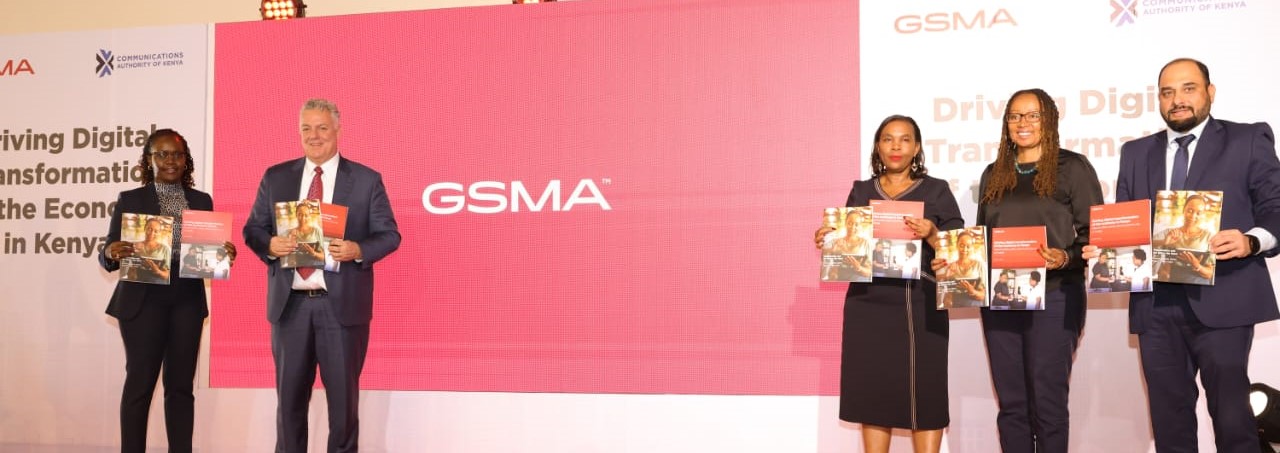Kenya’s Digital Economy to Contribute Over KSh. 600 Billion to GDP by 2028, GSMA Report Shows
The latest GSMA report, Driving Digital Transformation of the Economy in Kenya, projects that Kenya’s digital economy will contribute KSh 662 billion to GDP by 2028.
This growth, driven by strategic policy reforms, will accelerate digitalisation in critical sectors such as agriculture, manufacturing, transport, and trade. In addition to these advancements, the report forecasts the creation of 300,000 new jobs and an increase in tax revenues by Ksh150 billion. Kenya has firmly positioned itself as a leader in mobile financial services and digital innovation.
The Government of Kenya has recognised digitalisation as a cornerstone of its economic strategy, with the Kenya Vision 2030 and the Bottom-Up Economic Transformation Agenda (BETA) underscoring the integration of digital technologies into key sectors as essential for driving growth.
The GSMA’s study outlines the economic benefits of expanding digital adoption and provides a roadmap for maximising these gains through targeted policy actions. To sustain its economic momentum, diversify the economy, boost productivity, and create high-quality jobs – particularly for young and rural populations – Kenya is focusing on digitalisation as a key driver of economic growth, government revenue, and socio-economic development.
The public and private sectors must work together to address the dual challenges of device affordability and a lack of digital skills, which continue to impede the rapid development of our digital economy, according to David Mugonyi, Director General CA, in a speech read on his behalf by Lydia Setienei, Director, Legal Services and Corporation Secretary.
“Today we unveil this report whose recommendations and insights can help map a way forward for Kenya’s digital and economic transformation agenda. The growth of the ICT industry and the rapid speed of innovation calls for a responsive policy and legal framework, for our people to live, learn, and work and for businesses to thrive,” Mr. Mugonyi noted.
Alongside the report on Kenya’s digital economy, the GSMA has launched the Digital Africa Index (DAI) – a comprehensive tool that assesses digital adoption and usage across Africa. The DAI is designed to support policymakers in identifying areas of improvement to accelerate digital transformation. With Kenya among the top performers in Africa, the index highlights the importance of progressive policy and regulatory frameworks, which have facilitated Kenya’s leadership in mobile broadband adoption and innovation.
The Digital Africa Index further reinforces the potential for growth across Africa, with Kenya scoring above 50, alongside a few other African nations. The DAI and the accompanying Digital Policy and Regulatory Index (DPRI) help identify policy bottlenecks and offer benchmarks for countries aiming to boost their digital economies.
The GSMA’s report on Kenya’s digital economy highlights the transformative potential of digitalisation in key sectors that account for 58% of Kenya’s GDP. The adoption of digital technologies across agriculture, manufacturing, transport, and trade is expected to significantly contribute to GDP, create hundreds of thousands of jobs, and generate substantial tax revenues by 2028. In 2023, the mobile ecosystem contributed KSh 1.2 trillion to Kenya’s GDP and KSh 212 billion in government revenues.
However, the GSMA notes that significant gaps remain, and addressing these will require bold policy initiatives to stimulate demand, reduce supply costs, and encourage investments in mobile money services, telecom infrastructure, and digital services.
Kenya has made significant progress in expanding mobile network coverage – 99% of the population is covered by 3G, and 98% by 4G. However, only 33.5% of the population currently uses mobile Internet, leaving a significant usage gap. The GSMA, through its reports and the Digital Africa Index, projects that this gap could shrink from 63% to 46% by 2028, bringing over 1.5 million new users online and significantly expanding mobile money adoption. Despite Kenya’s extensive mobile coverage, smartphone adoption remains a barrier for many due to high costs.
The report recommends policy measures such as tax reductions and expanding device financing options, which could help millions more Kenyans access mobile internet services by 2028. Improving smartphone access would not only help close the internet usage gap but also increase active mobile money accounts, driving greater financial inclusion.
The GSMA reports offer several key policy recommendations to unlock the full potential of digital transformation: Reducing Sector-Specific Taxes: Lowering telecom sector taxes to incentivise infrastructure investment and reduce consumer costs.
Streamlining Licence Renewals: Accelerating the licence renewal process to provide certainty and stimulate network expansion. Improving Device Affordability: Implementing measures to make smartphones and other internet-enabled devices more affordable for lower-income households.
Supporting Digital Skills Development: Ensuring the population has the necessary digital skills to maximise the benefits of digitalisation.
Angela Wamola, Head of Sub-Saharan Africa at GSMA, stated: “Kenya has made remarkable strides in expanding mobile coverage and services. However, substantial gaps persist. Bold policy initiatives are necessary to boost demand, lower supply costs, and foster investment in digital infrastructure. Such measures promise broad benefits beyond mobile, catalysing productivity across all sectors and generating myriad employment opportunities for Kenya.”

